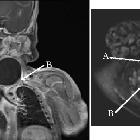tracheal diverticulum

















Tracheal diverticula, also known as tracheoceles, are usually an incidental finding. Occasionally it may mimic pneumomediastinum, so-called pseudopneumomediastinum.
Terminology
There is an overlap in the use and description of the terms paratracheal air cyst and a tracheal diverticulum in the literature that they often seem to be synonyms for the same entity .
Clinical presentation
Tracheal diverticula are typically asymptomatic but can occasionally present with chronic cough, stridor, dyspnea, or recurrent infection .
Pathology
Tracheal diverticula can be :
- congenital
- acquired
- prolonged increase intraluminal pressure, e.g. chronic cough, COPD
- tracheomalacia
- iatrogenic, e.g. post-surgical
Location
It projects posteriorly where the cartilage rings are deficient and usually lies to the right where there is no esophagus supporting the paratracheal tissue . The vast majority (97%) are located to the right posterolateral aspect of the trachea, about the level of the thoracic inlet . A direct connection with the trachea may not always be shown on CT .
Associations
- chronic obstructive pulmonary disease (COPD): for acquired type
- tracheobronchomegaly: when multiple tracheal diverticula are present
Treatment and prognosis
Although usually asymptomatic, it may accumulate respiratory secretions that become infected (and potentially abscess-forming) and lead to coughing or tracheobronchitis.
Differential diagnosis
Siehe auch:
- Zenker-Divertikel
- Mediastinalemphysem
- Killian-Jamieson-Divertikel
- Laryngozele
- zervikale bronchogene Zyste
- laterale Pharynxpouches
- angeborene Tracheobronchomegalie
- scheinbares zweites Lumen des oberen Ösophagus
- Bronchialdivertikel
- subcarinale Bronchialdivertikel
- pulmonale Blasen (blebs)
- kongenitale Anomalien des Tracheobronchialsystems
- Tracheotomie
- apical lung herniation
- paratracheale Luftansammlung Luftzyste
und weiter:

 Assoziationen und Differentialdiagnosen zu Trachealdivertikel:
Assoziationen und Differentialdiagnosen zu Trachealdivertikel:











